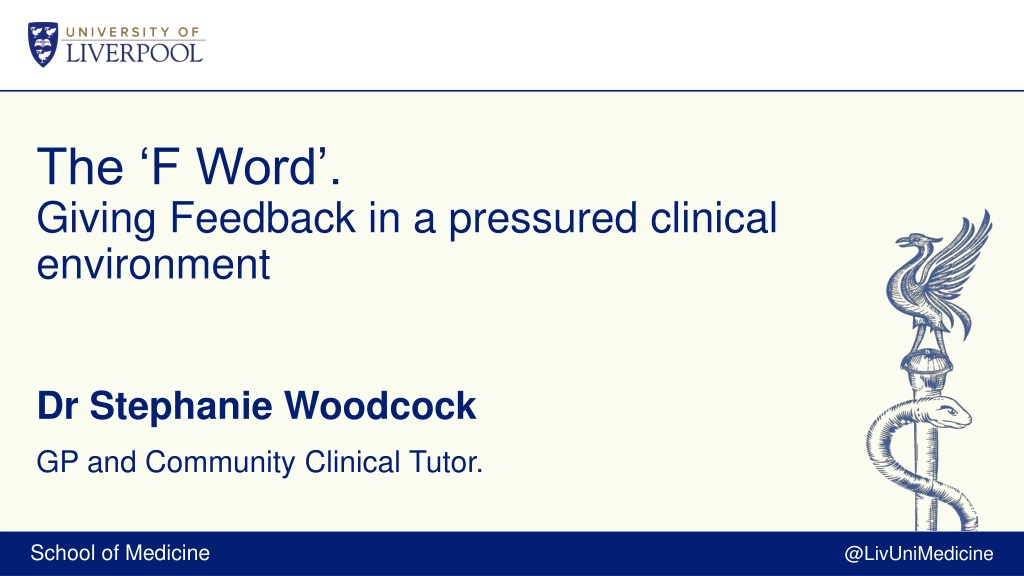

0 likes | 20 Views
This workshop addresses the challenges of giving feedback in busy clinical settings and aims to enhance confidence in providing feedback to medical students. It includes group activities, educational theory, feedback models, personal experiences, tips, and tricks. Various feedback models such as the Pendleton model, One Minute Preceptor method, and ALOBA model are explored to improve feedback interactions. Practical tips like giving feedback little and often, being specific and honest, and creating a safe environment for feedback are emphasized.

E N D
The ‘F Word’. Giving Feedback in a pressured clinical environment Dr Stephanie Woodcock GP and Community Clinical Tutor. School of Medicine @LivUniMedicine
Introduction and Workshop Outline 45 mins Workshop Aim is to help address some of the issues around giving feedback in the busy clinical environment and support you to feel confident giving feedback to students. 15mins: Group Activity 1:(10 mins discussion, 5 mins feedback) 15mins: Group Activity 2:(10 mins discussion, 5 mins feedback) 15mins: Educational theory, feedback models, personal experience, tips and tricks, questions. School of Medicine @LivUniMedicine
Feedback v Evaluation Evaluation is making a judgment about something or someone with little or no intention of changing any aspects or behaviours and is intended to be summative. Feedback on the other hand is providing formative information to improve performance regardless of the current performance and it is participatory for the learner.”1 Feedback is “Specific information about the comparison between a trainee’s observed performance and a standard, given with the intent to improve the trainee’s performance”2 School of Medicine . @LivUniMedicine
Group Activity 1 Reflect and share how, and when, you currently give feedback to students. School of Medicine @LivUniMedicine
Group Activity 2 What do you find difficult about giving feedback to student doctors in practice? School of Medicine @LivUniMedicine
Educational Theory on Giving Feedback in a Clinical setting Twelve tips for giving feedback effectively in the clinical environment. Ramani, S and Krackov, S. 2012 Common models and approaches for the clinical educator to plan effective feedback encounters. Orsini, C. et al. 2022 Feedback in the clinical setting. Burgess, A. et al. 2020 School of Medicine @LivUniMedicine
Feedback Models in Clinical Environments • Pendleton Rules 1) Educator asks student what went well 2) Educator engages in positive aspects conversation and may elaborate on these 3) Educator asks student what hasn’t gone well or could be improved 4) Educator engages in aspects that could be improved and gives their perspective on this Example of giving feedback: Pendleton model School of Medicine @LivUniMedicine
Feedback Models cont... • One Minute Preceptor 1) Student sets commitment 2) Enquire re supporting evidence and students rationale 3) Teach general rules 4) Reinforce what was right/what went well 5) Correct any mistakes OMP method Example of giving feedback: OMP method School of Medicine @LivUniMedicine
Feedback Models cont... • ALOBA (Agenda-Led Outcome-Based Analysis) 1) Student sets agenda 2) Define outcomes 3) Encourage student to reflect on situation and self-assess what could have gone better 4) Provide descriptive and balanced feedback 5) Discuss suggestions and alternatives to reach outcome 6) Check feedback acceptance, summarise, action plan Example of giving feedback: ALOBA model School of Medicine @LivUniMedicine
Personal Experience Students respond well to regular feedback Allow yourself time, if possible, to give feedback at the end of an interaction between student and patient Make notes to refer back to in the educational supervisor meetings if needed Consider giving written feedback in their portfolio Aim to provide a safe and welcoming environment. This will make feeding back easier • • • • • School of Medicine @LivUniMedicine
Tips and Tricks •Give feedback little and often rather than large amounts at once. •Try to feedback at the time of the event, or shortly after. •Make sure the student is aware you are giving feedback. •Be specific and honest •Feedback on what you directly observe and use language that reflects that eg. ‘I noticed…’, ‘I observed…’ •Involve the student and their observations 'when you did...what did you notice..?' •Focus on the outcome and summarise. School of Medicine @LivUniMedicine
Questions? School of Medicine @LivUniMedicine
References 1) https://intranet.med.wisc.edu/faculty-affairs-and-development/faculty- central-resources/developing-educators/feedback-and-evaluation/ 2) Van den Berg I, Admiraal W, Pilot A. Peer assessment in university teaching: evaluating seven course designs. Assess Eval High Educ. 2006;31(1):19–36. School of Medicine @LivUniMedicine
Thank you. School of Medicine @LivUniMedicine